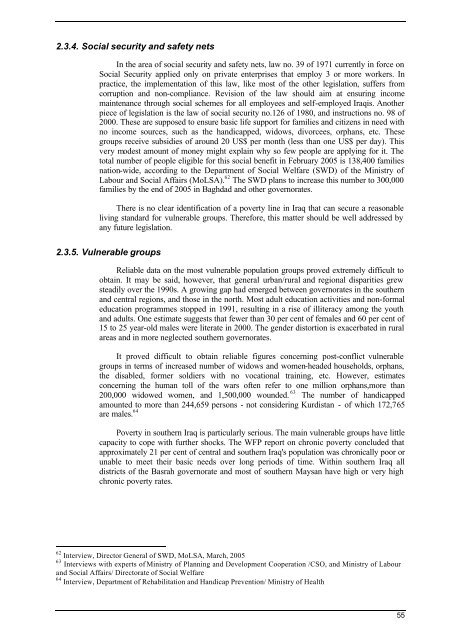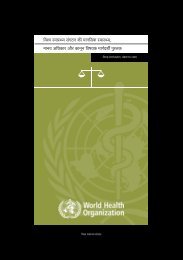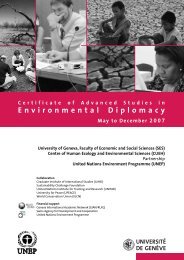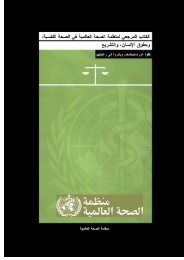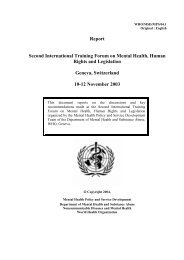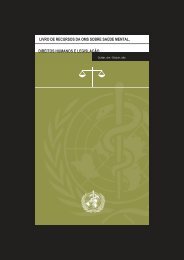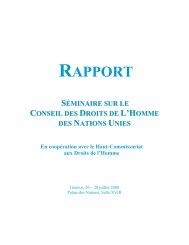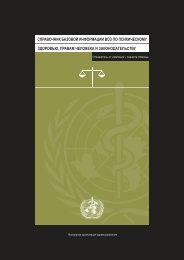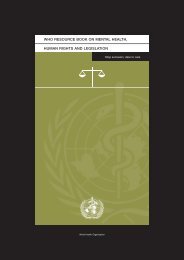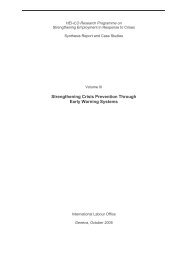for university education concerning age groups between 18 and 23 from 7.9 per cent in1987/1988 to 10.2 per cent in 2001/2002, the percentage remains very modest.Average enrolment rates concealed substantial regional, rural/urban and genderdisparities. Regional Primary Education shows NERs ranged from 98 per cent in Baghdadand Diala to around 63 per cent in Muthanna between 1998 and 1999. These NERs largelyreflected rural/urban disparities, with 98 per cent in urban areas and around 61 per cent inrural areas. The female share of Primary Education enrolment remained fairly constant ataround 44 per cent throughout the period 1990/2000. The 2000 MICS survey, however,identified significant gender gaps in Primary Education attendance, especially in ruralareas, where up to 51 per cent of girls (compared with 28 per cent of boys) were reportedto be out of school. In Secondary Education, gender gaps became more marked, asindicated in the table below.Table 2: Educational gender gaps in secondary educationGross enrolment, Gross enrolment,NER,1990/19911999/20001999/2000Male 57.1 47.1 39.6Female 36.4 29.1 26Total 47 38.3The Ministry of Education (MoE) and UNICEF estimated that at least 80 per cent ofthe MoE’s 13,200 establishments (including schools) needed some form of rehabilitationand repair. Overall (primary and secondary) student-classroom ratio is of 49:1. In addition,the MoE reported that more than 700 schools and institute buildings were currently beyondrepair and needed to be demolished and rebuilt. The enrolment simulation and projectionmodel used for this assessment suggested that a minimum of 4,500 new schools, inaddition to the 700 institutes to be rebuilt, were required in order to cope with enrolmentgrowth and to eliminate double and triple shifts.2.3.3. HealthThe previous regime’s disregard for social issues, the consecutive wars and UNeconomic sanctions caused a disastrous deterioration of the health system and standardsreflected in the following health indicators: 61• the number of hospitals and other health centres declined between 1987 and 2002 from234 to 212 hospitals and from 1,604 to 1,078 health centres;• the average population per doctor ratio remains considerably elevated (2,319 in 2002compared to 1,925 in 1987);• there were 1,013 people per available hospital bed in 2003, compared with 515 in1987;• the infant mortality rate was at 108 per 1,000 live births and the average death rate forchildren under 5 years age was 130.6 per 1000 live births during the period from 1994to 1999, compared to 25-30 and 50 child deaths respectively from 1984 to 1989.Maternal death rates also increased, from 117 cases per 100,000 live births to 294 from1991 to 1999;• the Iraqi life expectancy rate has fallen from 62.5 in 1987 to 58.5 years of age in 1997.61 UN-WB Joint Assessment of Reconstructing and Rebuilding in Iraq, Oct.,200354
2.3.4. Social security and safety netsIn the area of social security and safety nets, law no. 39 of 1971 currently in force onSocial Security applied only on private enterprises that employ 3 or more workers. Inpractice, the implementation of this law, like most of the other legislation, suffers fromcorruption and non-compliance. Revision of the law should aim at ensuring incomemaintenance through social schemes for all employees and self-employed Iraqis. Anotherpiece of legislation is the law of social security no.126 of 1980, and instructions no. 98 of2000. These are supposed to ensure basic life support for families and citizens in need withno income sources, such as the handicapped, widows, divorcees, orphans, etc. Thesegroups receive subsidies of around 20 US$ per month (less than one US$ per day). Thisvery modest amount of money might explain why so few people are applying for it. Thetotal number of people eligible for this social benefit in February 2005 is 138,400 familiesnation-wide, according to the Department of Social Welfare (SWD) of the Ministry ofLabour and Social Affairs (MoLSA). 62 The SWD plans to increase this number to 300,000families by the end of 2005 in Baghdad and other governorates.There is no clear identification of a poverty line in Iraq that can secure a reasonableliving standard for vulnerable groups. Therefore, this matter should be well addressed byany future legislation.2.3.5. Vulnerable groupsReliable data on the most vulnerable population groups proved extremely difficult toobtain. It may be said, however, that general urban/rural and regional disparities grewsteadily over the 1990s. A growing gap had emerged between governorates in the southernand central regions, and those in the north. Most adult education activities and non-formaleducation programmes stopped in 1991, resulting in a rise of illiteracy among the youthand adults. One estimate suggests that fewer than 30 per cent of females and 60 per cent of15 to 25 year-old males were literate in 2000. The gender distortion is exacerbated in ruralareas and in more neglected southern governorates.It proved difficult to obtain reliable figures concerning post-conflict vulnerablegroups in terms of increased number of widows and women-headed households, orphans,the disabled, former soldiers with no vocational training, etc. However, estimatesconcerning the human toll of the wars often refer to one million orphans,more than200,000 widowed women, and 1,500,000 wounded. 63 The number of handicappedamounted to more than 244,659 persons - not considering Kurdistan - of which 172,765are males. 64Poverty in southern Iraq is particularly serious. The main vulnerable groups have littlecapacity to cope with further shocks. The WFP report on chronic poverty concluded thatapproximately 21 per cent of central and southern Iraq's population was chronically poor orunable to meet their basic needs over long periods of time. Within southern Iraq alldistricts of the Basrah governorate and most of southern Maysan have high or very highchronic poverty rates.62 Interview, Director General of SWD, MoLSA, March, 200563 Interviews with experts of Ministry of Planning and Development Cooperation /CSO, and Ministry of Labourand Social Affairs/ Directorate of Social Welfare64 Interview, Department of Rehabilitation and Handicap Prevention/ Ministry of Health55
- Page 1 and 2:
HEI-ILO Research Programme onStreng
- Page 3:
PrefaceThis three-volume series res
- Page 7 and 8:
Table of contentsPreface...........
- Page 9:
The Private Sector and Social Partn
- Page 13: Executive summaryPrivate enterprise
- Page 16 and 17: IGOs, NGOs—tend to exclude, or at
- Page 18 and 19: • The World Bank has created a kn
- Page 20 and 21: 2. Private enterprises in conflict-
- Page 22 and 23: Figure 1: The Private Sector Employ
- Page 24 and 25: 2.3. Case study: Promoting multi-et
- Page 26 and 27: downstream, i.e. refining and distr
- Page 28 and 29: Box 1: How does Somalia’s private
- Page 30 and 31: Sectoral aspectsthere will be added
- Page 32 and 33: inequities in pricing. “Of the 16
- Page 34 and 35: into the armies are thereby also at
- Page 36 and 37: 3. Private enterprises and social p
- Page 38 and 39: Two natural disasters which have be
- Page 40 and 41: Box 4: Cooperatives in crisis respo
- Page 42 and 43: partners, the tripartite cooperatio
- Page 44: 36forces and that are able to perfo
- Page 48: AcknowledgmentsThe authors of this
- Page 51 and 52: 6.2. Delimiters of women’s econom
- Page 54 and 55: Executive summaryDespite the rich n
- Page 56 and 57: 1. IntroductionSince 1979, under th
- Page 58 and 59: 2. Country profileThe Republic of I
- Page 60 and 61: • activities related to reconstru
- Page 64 and 65: 2.4. Economic environment assessmen
- Page 66 and 67: Unemployment (15 years of age and a
- Page 68 and 69: 2.5. PerspectivesDespite devastatio
- Page 70 and 71: 3. The rationale of SME sector deve
- Page 72 and 73: 4. Iraq's SME sector: A profile4.1.
- Page 74 and 75: The Private sector employment pyram
- Page 76 and 77: Table 8: Estimates of total formal
- Page 78 and 79: Feasibility study: almost all respo
- Page 80 and 81: Table 9: Percentage of female entre
- Page 82 and 83: Factors for public sector preferenc
- Page 84 and 85: The recessionary indication of busi
- Page 86 and 87: Special investment legislation and
- Page 88 and 89: 8. Small entrepreneurs in Iraq: Sto
- Page 90 and 91: a reasonable income and independenc
- Page 92 and 93: 9. RecommendationsSME-development s
- Page 94 and 95: Longer-term SME developmentBesides
- Page 96 and 97: • literature and artistic service
- Page 98 and 99: 2. List of interviews with governme
- Page 100 and 101: 11. Why did you decide establishing
- Page 102 and 103: 33. What are the cost components of
- Page 104 and 105: 59. Are you working on a project, o
- Page 106: Promoting multi-ethnic stakeholder
- Page 109 and 110: 101
- Page 111 and 112: 103
- Page 113 and 114:
105
- Page 115 and 116:
107
- Page 117 and 118:
109
- Page 119 and 120:
Research methodologyThe research te
- Page 121 and 122:
possibility of conflict. In 1992, a
- Page 123 and 124:
2.2.2. PovertyAfter the break-up of
- Page 125 and 126:
of almost 10 per cent of GDP, yet i
- Page 127 and 128:
Source of initial financing: privat
- Page 129 and 130:
‘It is important to point out tha
- Page 131 and 132:
4.2. The economic resilience of int
- Page 133 and 134:
medium-sized companies employing 24
- Page 135 and 136:
5.2. Addressing constraints for SME
- Page 137 and 138:
5.4. Support to local initiativesSM
- Page 139 and 140:
ConclusionConsidering the actual an
- Page 141 and 142:
Scott, Norman: Macedonia: A Brief E
- Page 143 and 144:
Official gross reserves 4 290 450 7
- Page 145 and 146:
4. Survey questionnaire1. Name of t
- Page 147 and 148:
139
- Page 149 and 150:
141
- Page 151 and 152:
143
- Page 153 and 154:
2. Le contexte2.1. Le paradoxe ango
- Page 155 and 156:
Composition et description des Futu
- Page 157 and 158:
Les généraux angolais sont prése
- Page 159 and 160:
Les syndicats officielsL’Union na
- Page 161 and 162:
Une étude réalisée en 2003 pour
- Page 163 and 164:
3.3. Sortir du cercle vicieux : vie
- Page 165 and 166:
Annexes1. Morceaux choisis : le «
- Page 167 and 168:
159
- Page 169 and 170:
L’implication des partenaires soc
- Page 171 and 172:
Table des matièresTable des matiè
- Page 173 and 174:
RemerciementsQu’il me soit permis
- Page 175 and 176:
Liste des acronymesAFASPAALEANEAANS
- Page 177 and 178:
GlossaireAide d’urgence :Aléa :A
- Page 179 and 180:
Résumé exécutifAu cours des dix
- Page 181 and 182:
1. IntroductionLe département de R
- Page 183 and 184:
Limites de l’étudeAvant de proc
- Page 185 and 186:
évalué à plus de deux milliards
- Page 187 and 188:
2.2.2. Aspects démographiquesLes p
- Page 189 and 190:
2.3.3. EducationDès l’indépenda
- Page 191 and 192:
création de fonds de stabilisation
- Page 193 and 194:
3. Analyse des formes de réponse :
- Page 195 and 196:
• le secteur de l’Eau sera dest
- Page 197 and 198:
• la révision de la législation
- Page 199 and 200:
de main-d’œuvre, encourageant la
- Page 201 and 202:
leur fournissait les équipements e
- Page 203 and 204:
matérielle sous des formes diverse
- Page 205 and 206:
centre de l’attention des partena
- Page 207 and 208:
• le rôle dévolu à la commissi
- Page 209 and 210:
Renforcer le rôle de solidarité d
- Page 211 and 212:
ConclusionLa dimension de la tache
- Page 213 and 214:
Equipe Multidisciplinaire pour l’
- Page 215 and 216:
2. Séries statistiquesTable 8 : Ev
- Page 217 and 218:
Table 11 : Répartition de la popul
- Page 219 and 220:
Table 2 : Liste détaillée des com
- Page 221 and 222:
Table 4 : Dispositif d’interventi
- Page 223 and 224:
Organisation de l’unité syndical
- Page 225 and 226:
- Centre technique de construction.
- Page 227:
219


